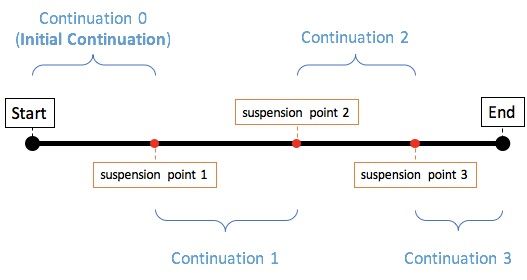Kotlin协程实现原理
为什么需要协程?
协程可以简化异步编程,可以顺序地表达程序,协程也提供了一种避免阻塞线程并用更廉价、更可控的操作替代线程阻塞的方法 – 挂起函数。
Kotlin 的协程是依靠编译器实现的, 并不需要操作系统和硬件的支持。编译器为了让开发者编写代码更简单方便, 提供了一些关键字(例如suspend), 并在内部自动生成了一些支持型的代码。
实现细节
Continuation passing style(CPS)
挂起函数通过Continuation passing style(CPS)来实现。当挂起函数被调用的时候,会有一个额外的Continuation参数传递给它。回想一下await挂起函数的声明如下所示:
suspend fun CompletableFuture.await(): T
但是,在通过CPS转换之后它的真实的方法声明如下所示:
fun CompletableFuture.await(continuation: Continuation): Any?
我们看到类型参数T移动到了Continuation参数的类型参数(就是泛型参数)的位置上。方法实现的返回类型变成了Any?。为什么方法实现的返回类型要变成Any?呢?因为当挂起函数挂起协程的时候,挂起函数返回一个特殊的标记值COROUTINE_SUSPENDED(详情参考coroutine intrinsics章节)。
当挂起函数没有挂起协程,继续协程执行的时候,挂起函数会立即返回执行结果或者抛出一个异常。这样,await方法返回类型Any?实际上是COROUTINE_SUSPENDED和T的并集。(类比Java,就好比一个方法既可以返回String类型又可以返回Integer类型,那么我们就声明这个方法返回Object)。
实际实现挂起函数的时候,不允许在它的栈帧中直接调用continuation,因为这有可能导致长时间运行的协程栈溢出。为什么呢?我的理解是因为如果一个协程很长的话,里面会有很多挂起点,那么每次从一个挂起点恢复的时候就会调用一次resumeWith(Object result)方法(每次方法调用对应一个栈帧),也就是说resumeWith(Object result)方法会被多次调用,是有可能导致栈溢出的。(类比Java,调用递归方法的时候就要注意栈溢出问题)。标准库中的suspendCoroutine函数通过跟踪continuation的调用向开发人员隐藏了这种复杂性,并且确保continuation无论以何种方式以及何时被调用,都与挂起函数的实际实现约定一致。
State machines(状态机)
高效实现协程是很关键的,例如尽可能使用更少的类和对象。很多语言使用状态机来实现协程,Kotlin也是使用状态机的方式来实现的。对于Kotlin,这种方式导致编译器为每个包含挂起函数的lambda表达式生成一个类,包含挂起函数的lambda表达式中可以有任意数量的挂起点。
核心思想:一个包含挂起函数的lambda表达式被编译成了一个状态机,状态对应挂起点,例如下面的这个lambda表达式体内有两个挂起点。
GlobalScope.launch {
val a = a()
val y = foo(a).await() // 挂起点1
b()
val z = bar(a, y).await() // 挂起点2
c(z)
}
这个代码块有3个状态:
- 初始化(在任何挂起点之前,也就是上面代码块中的第一行)
- 在第一个挂起点之后
- 在第二个挂起点之后
每个状态都是都是一个continuation的入口。如下图所示。图片来自Kotlin Coroutines(协程) 完全解析(二),深入理解协程的挂起、恢复与调度
上面的代码块被编译成一个匿名内部类,该类有一个方法来实现状态机,有一个成员变量来标志当前状态机的状态。该匿名类的Java伪代码如下所示:
class extends SuspendLambda<...> {
// 标志当前状态机的状态
int label = 0
// 协程的局部变量,就是上面在lambda表达式体内声明的变量
A a = null
Y y = null
//该方法用来实现状态机
void resumeWith(Object result) {
if (label == 0) goto L0
if (label == 1) goto L1
if (label == 2) goto L2
else throw IllegalStateException()
L0:
// result is expected to be `null` at this invocation
a = a()
label = 1
//注释1处
result = foo(a).await(this) // 'this' is passed as a continuation
//注释2处
if (result == COROUTINE_SUSPENDED) return // return if await had suspended execution
L1:
// external code has resumed this coroutine passing the result of .await()
y = (Y) result
b()
label = 2
result = bar(a, y).await(this) // 'this' is passed as a continuation
if (result == COROUTINE_SUSPENDED) return // return if await had suspended execution
L2:
// external code has resumed this coroutine passing the result of .await()
Z z = (Z) result
c(z)
label = -1 // No more steps are allowed
return
}
}
注释1处
result = foo(a).await(this) // 'this' is passed as a continuation
把当前对象’this’作为一个continuation传递给挂起函数。
注释2处
if (result == COROUTINE_SUSPENDED) return // return if await had suspended execution
如果挂起函数await挂起了即返回了特殊的标记变量COROUTINE_SUSPENDED,就直接返回。
上面伪代码执行步骤
-
当协程开始的时候,我们调用
resumeWith,此时label是0,我们跳转到L0,然后执行一些操作,然后将label设置为下一个状态1,调用.await()并且当.await()方法挂起的时候直接return。 -
当协程挂起恢复,继续执行的时候,我们再次调用
resumeWith,此时跳转到L1,然后执行一些操作,然后将label设置为下一个状态2,调用.await()并且当.await()方法挂起的时候直接return。 -
当协程挂起恢复,继续执行的时候,我们再次调用
resumeWith,此时跳转到L2,将label设置为-1,也就是说协程执行结束。
循环中的挂起点
在一个循环中的挂起点只生成一个状态,因为循环也通过有条件的goto来工作。
var x = 0
while (x < 10) {
x += nextNumber().await()
}
生成的伪代码
class extends SuspendLambda<...> {
// The current state of the state machine
int label = 0
// local variables of the coroutine
int x
void resumeWith(Object result) {
if (label == 0) goto L0
if (label == 1) goto L1
else throw IllegalStateException()
L0:
x = 0
LOOP:
//注释1处
if (x > 10) goto END
label = 1
result = nextNumber().await(this) // 'this' is passed as a continuation
if (result == COROUTINE_SUSPENDED) return
L1:
// 注释2处
x += ((Integer) result).intValue()
label = -1
goto LOOP
END:
label = -1 // No more steps are allowed
return
}
}
在注释2处,每次累加结果后到会跳转到LOOP标签。
注释1处,判断当x>10就跳转到END,表示执行结束。
参考链接
- Coroutines design document (KEEP)
Implementation details一节。 - Kotlin Coroutines(协程) 完全解析(二),深入理解协程的挂起、恢复与调度
